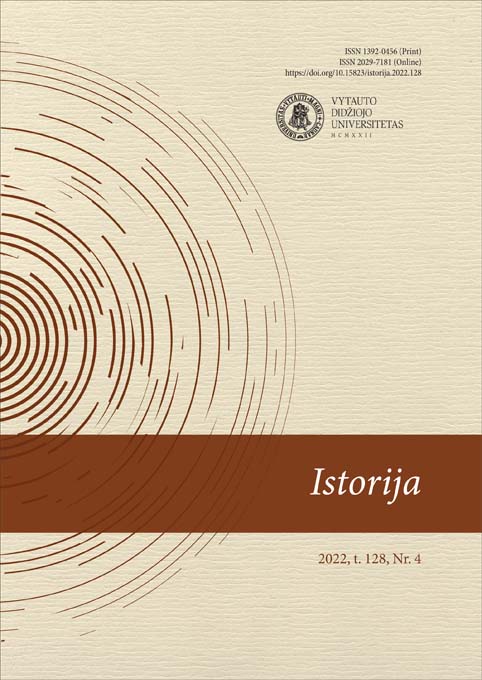Kai kurie informacinės politikos bruožai 1990–1992 m. periodinės žiniasklaidos aspektu
Some Features of Information Politics in 1990–1992 in Terms of Periodical Media
Author(s): Andrius VaišnysSubject(s): History, Political history
Published by: Vytauto Didžiojo Universitetas
Keywords: Information politics; Supreme Council; Daily “Lietuvos Aidas” (“Echo of Lithuania”); Government; Privatization; Press, and government relations;
Summary/Abstract: Lietuvos Aukščiausiajai Tarybai 1990 m. paskelbus atkuriant nepriklausomą valstybę, jau metų pradžioje veikė priimtas Spaudos ir kitų masinės informacijos priemonių įstatymas, kurį lėmė visuomenės judėjimo – Sąjūdžio spaudimas komunistinei valdžiai atsisakyti cenzūros. Žiniasklaidos sistemos transformacija nuo 1989 m. vyko kintant komunistiniam modeliui ir medijoms tampant labiau nepriklausomoms nuo valdžių. Ji aprėpė metų pradžioje Lietuvoje legaliai leidžiamą kelių rūšių žiniasklaidą, skirstytiną pagal savininkystę – priklausančią Komunistų partijai ir komunistinei vyriausybei (kaip antai Lietuvos radijo ir televizijos komitetas, laikraščiai); Komunistų partijai ir skirtingo lygmens administracinėms struktūroms (kaip antai Aukščiausiajai Tarybai, Ministrų Tarybai, rajonų „liaudies deputatų“ taryboms) priklausančius dienraščius ir vietinę regionų periodiką (kuri priklausė valstybinei įmonei – laikraščių ir žurnalų susivienijimui „Periodika“); nuo Lietuvos komunistų partijos (LKP) ir Lietuvos Lenino komunistinės jaunimo sąjungos (LLKJS) pavaldumo atleistą arba / ir jų lėšomis įsteigtą žiniasklaidą; Sąjūdžio regioninėmis iniciatyvomis įsteigtą žiniasklaidą arba / ir nuo Sąjūdžio organizacijos pavaldumo atleistą žiniasklaidą ir naujai besikuriančią spaudą bei radijo stotis. Lietuvos Respublikos Aukščiausiosios Tarybos vadovybė ir naujoji vyriausybė ėmėsi formuoti informacinę politiką (inicijuodama atitinkamus teisės aktus) bei skirstyti lėšas, kad galėtų steigti medijas arba / ir keisti jų statusą, daryti įtaką medijų turiniui ir apskritai žiniasklaidos sistemai. / When the Supreme Council of Lithuania announced the restoration of an independent state in 1990, the Law on Press and Other Mass Information adopted at the beginning of the year was already in effect. The adoption of the law was determined by the pressure of the public movement – “Sąjūdis: to abandon the censorship characteristic of the entire Soviet Union. Therefore, the transformation of the media system has already taken place since 1989 with the change of the communist model and the media becoming more independent from the authorities. This transformation covered several types of media legally published in Lithuania at the beginning of the year, divided by owners: belonging to the Communist Party and the communist government (such as the Lithuanian Radio and Television Committee, newspapers); dailies belonging to the Communist Party and administrative structures of different levels (such as the Supreme Council, the Council of Ministers, district councils of “people’s deputies”) and local regional periodicals (which belonged to the state-owned enterprise – the association of newspapers and magazines “Periodika”); media outlets established with their funds and/or released from the control of the Lithuanian Communist Party (LKP) and Lenin’s Communist Youth Union; media established by regional initiatives of “Sajudis: movement and / or media released from the subordination of “Sajudis” and newly established periodicals and radio stations. After the parliamentary elections, the leadership of the Supreme Council of the Republic of Lithuania and the new government began to form an information policy, initiating relevant legislation and allocating funds in order to be able to create media and / or change their status, influence media content. The purpose of the article is to investigate and discuss how this policy was implemented, by allocating and distributing financial and material support to the media, and what circumstances led to the conflicts. By applying the empirical method, documents about the decisions of the authorities were collected and analyzed, the analysis of which allows to evaluate the emergence of new media politics and publications in periodicals related to those decisions. These sources, testifying to the information policy, have not been examined so far.
Journal: Istorija. Lietuvos aukštųjų mokyklų mokslo darbai
- Issue Year: 128/2022
- Issue No: 4
- Page Range: 79-122
- Page Count: 44
- Language: Lithuanian

